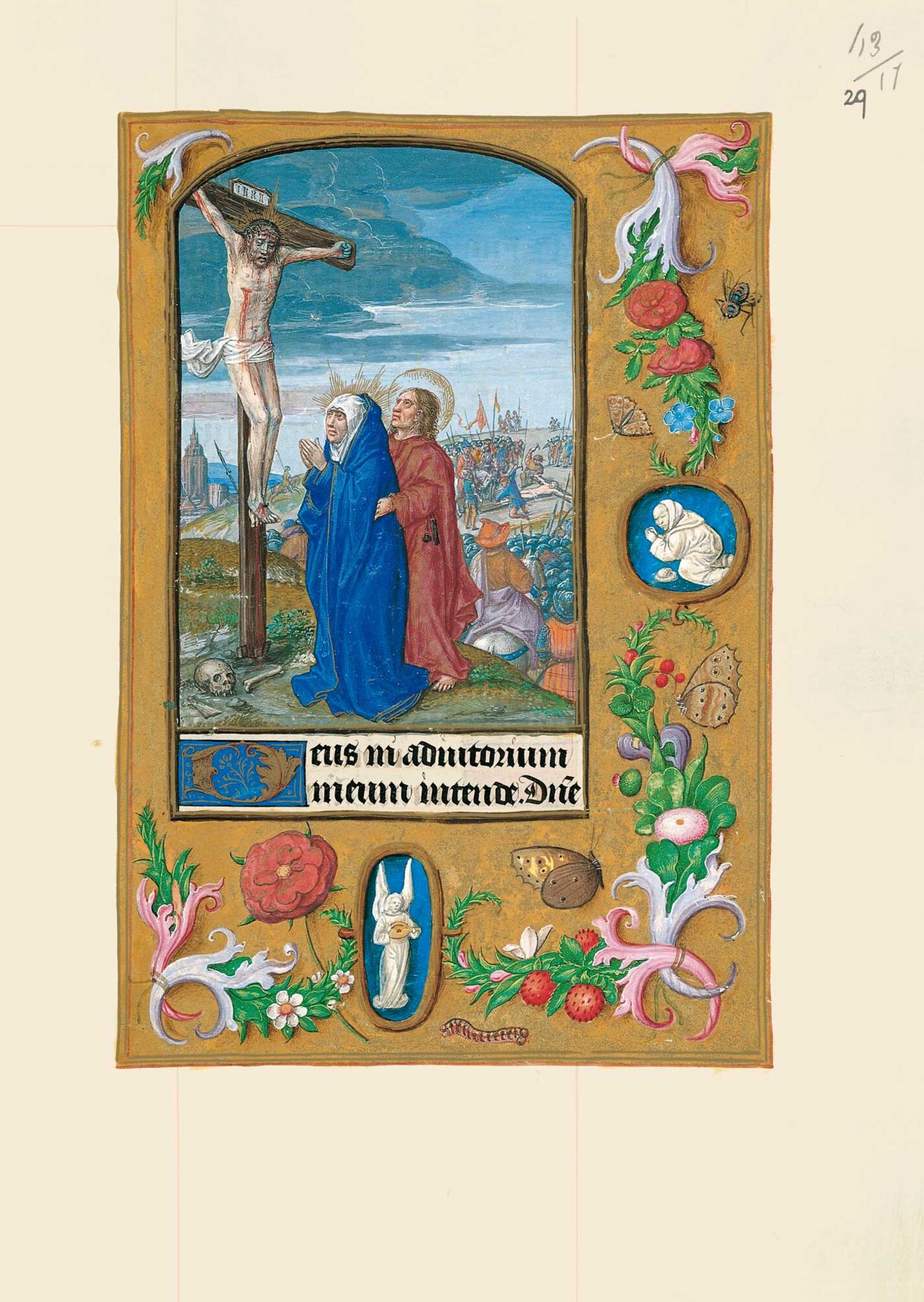The earlier scene in time, i.e. Jesus nailed to the cross, is relegated to the background to highlight the crucifixion. The cross is depicted on the ground on the right-hand side of the background of the miniature, surrounded by the authorities and a crowd of soldiers an aspect that Gérard Horenbout, or possibly his son Lucas, was to employ subsequently and in greater detail in the Hours of Bona Sforza, made around 1517-1521 (London, The British Library, Add. Ms. 34294, f. 12v). Also shown are two men, one nailing Christ’s feet and the other, his right hand. Further in the distance, practically on the horizon, soldiers cast lots for the Lord’s seamless tunic. Two iconographic formulae existed: the cross laid upon the ground or set upright. The one used in this instance is the former, whose origins lie in Byzantine art from the 11th century onwards, as can be seen in the Greek Barberini Psalter, from which it subsequently entered French and Flemish art. To the north of the Alps, this scene appears as a composition with countless figures that sometimes acts as a secondary motif in the crucifixion image. On German and Dutch Passion altars and in Flemish triptychs, this scene precedes that of the crucifixion, as revealed by a painting on the centre panel of a small triptych attributed to Gérard David and dated around 1480-1490 (London, National Gallery). A dead Christ can be seen in the foreground upon the tau-shaped cross with “inri” above the crossbar and no suppedaneum supporting his feet. The Saviour’s blood flows to the ground where a skull and tibia lie. Opposite him is the Virgin, with a sorrowful expression and her hands together. Christ’s mother is held up by St John, who looks at the Lord’s face, to prevent her from falling to the ground. The authorities and the crowd of soldiers withdraw from the execution place. Gérard Horenbout creates a highly expressive and realistic cloudscape that suggests an evening with contrasting light in which the palest area is occupied by Christ being nailed to the cross and the darkest, by the crucifixion. The outcome is a dramatic climate of impending doom in keeping with the solemnity of the moment, in contrast with the lontana città of Jerusalem featuring the tall tower of a church in an attempt to endow the scene with realism. Our Lady looks sad but not overwhelmed by sorrow or desperation, even though St John helps prevent her from possibly falling to the ground, according to the theory of some early-fourteenth-century, Marian commentators. This theory became increasingly accepted, as can be seen in book written in 1506, possibly shortly after the Hours of Joanna of Castile was painted, entitled De Spasimo Beatae Virginis Mariae by the Dominican Tommaso de Vio, which denies that Our Lady manifested her own torment and fell to the ground. The bones at the foot of the cross hark back to both the meaning given to Golgotha by the evangelists, i.e. skull, and Adam’s presence beneath Golgotha in line with a tradition, mentioned in the Book of Adam and Eve from Ethiopia and the Cave of Treasures which was very widespread in the Middle Ages, according to which the first man was buried on the very spot where Christ was to be sacrificed, where he would be saved. The Cave of Treasures says that when “the Messiah achieved victory by the spear, blood and water flowed down from his side towards Adam’s mouth and this was his baptism and thus was he baptised”. Hence, Adam’s bones must be interpreted as the fall and the fulfilled promise of redemption.
